
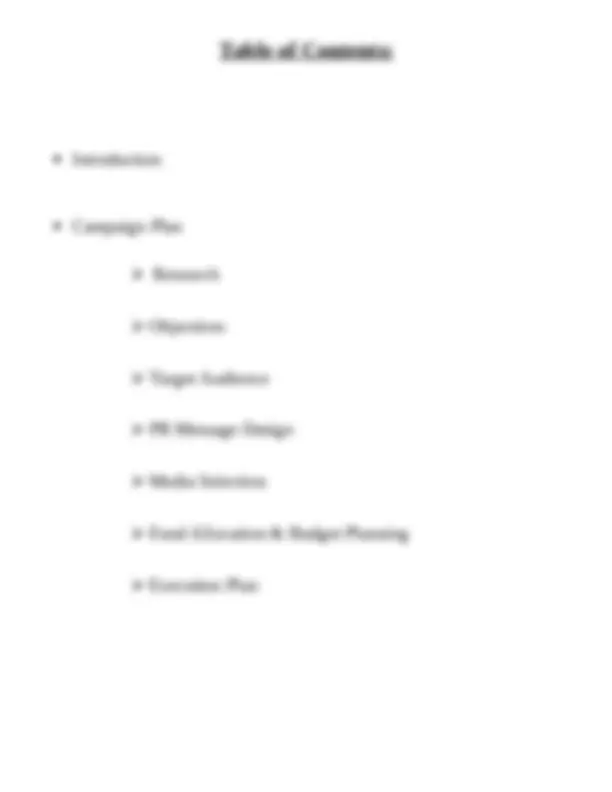
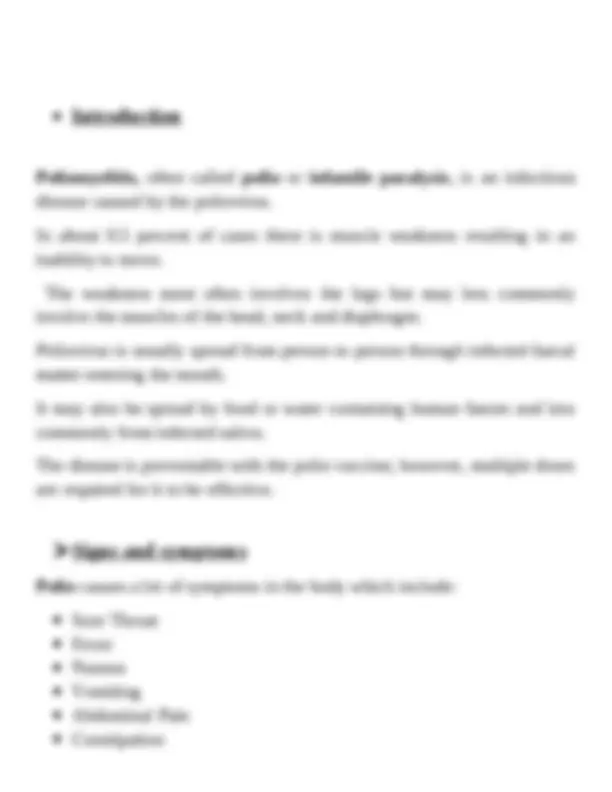
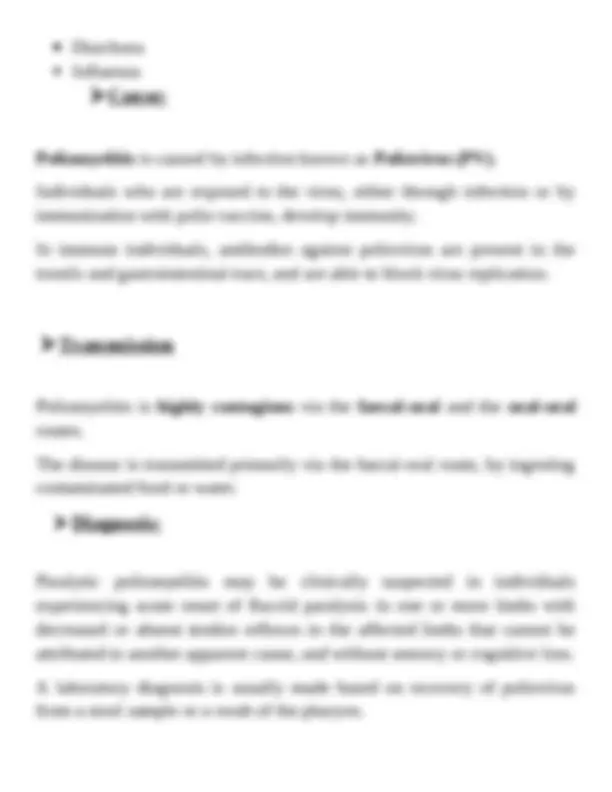
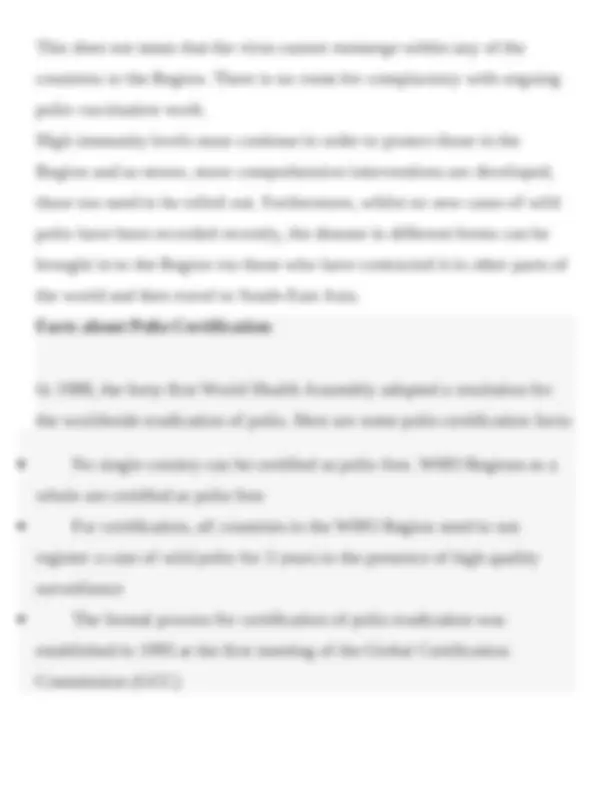
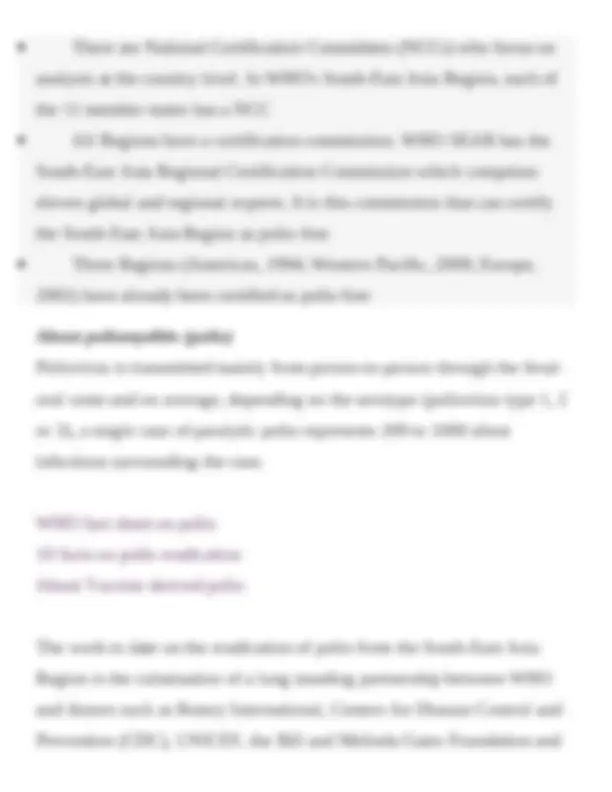
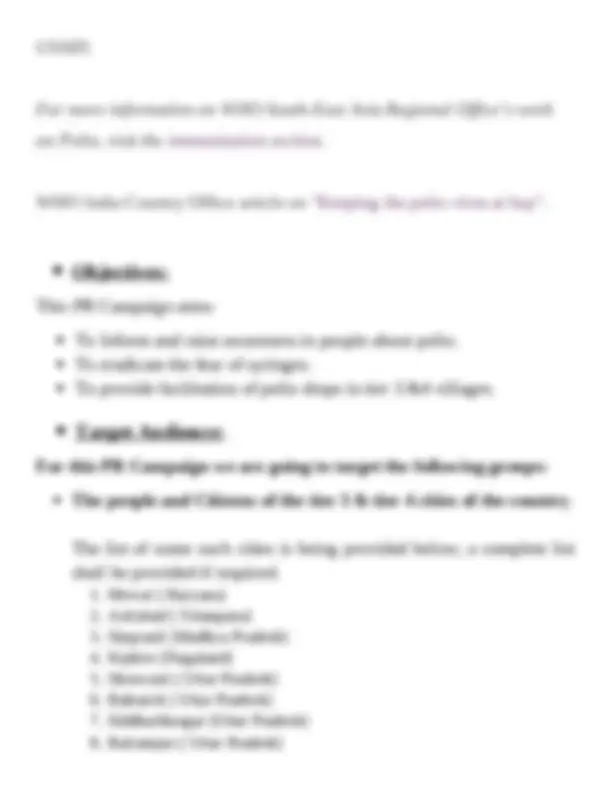
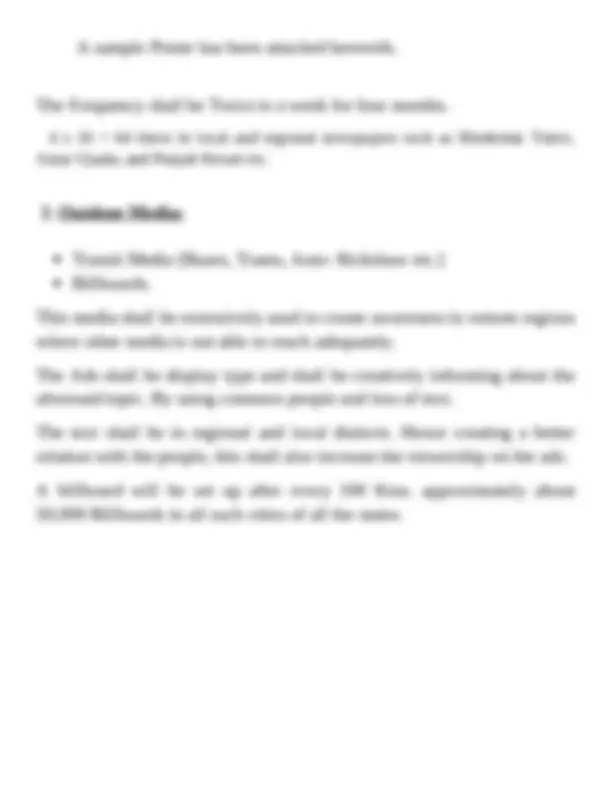
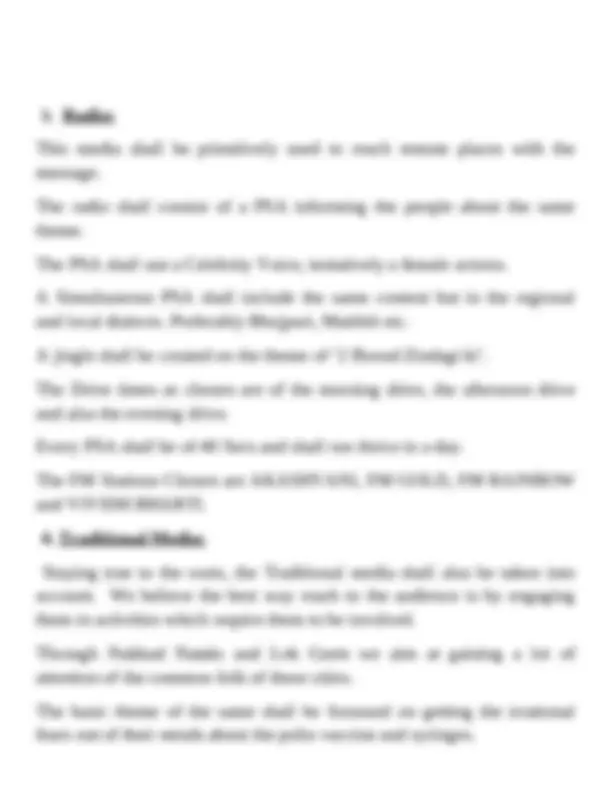
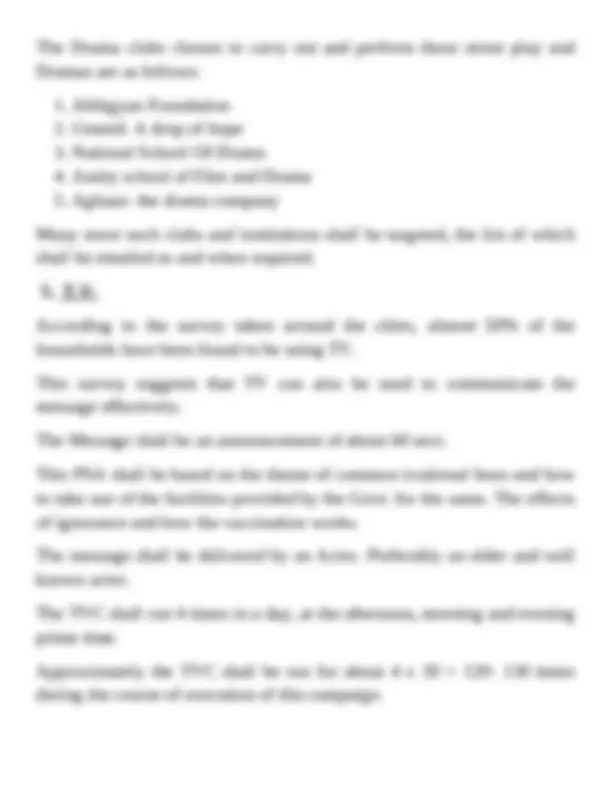
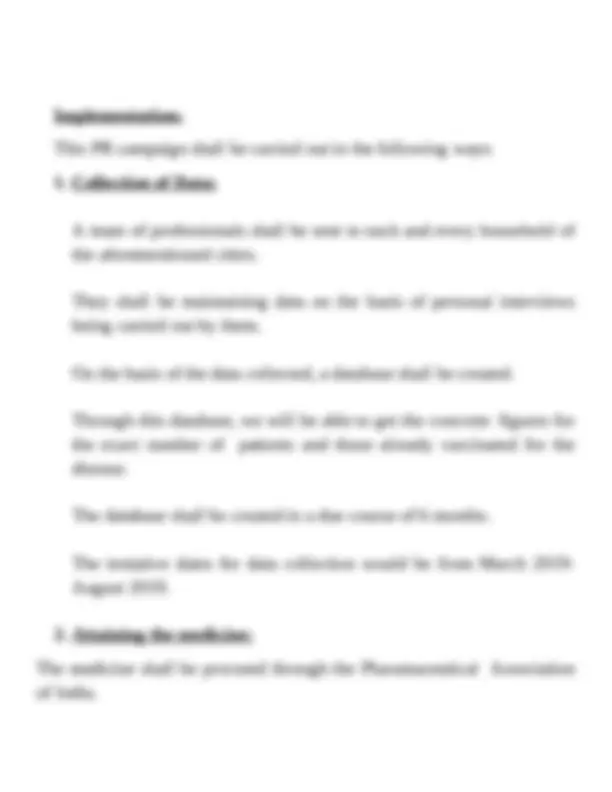
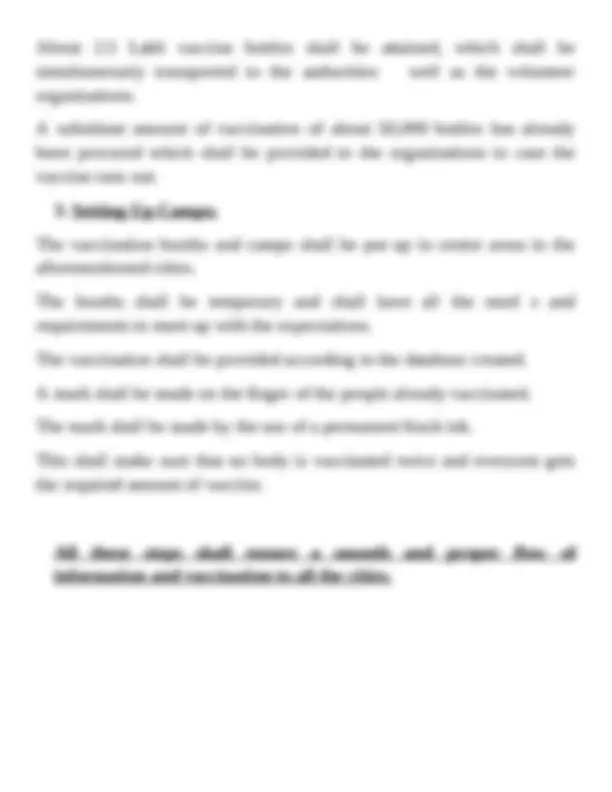
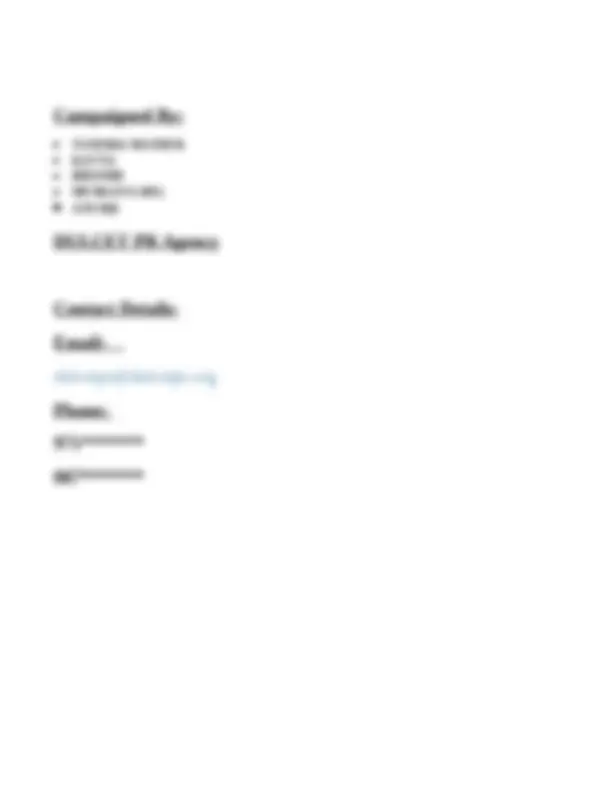
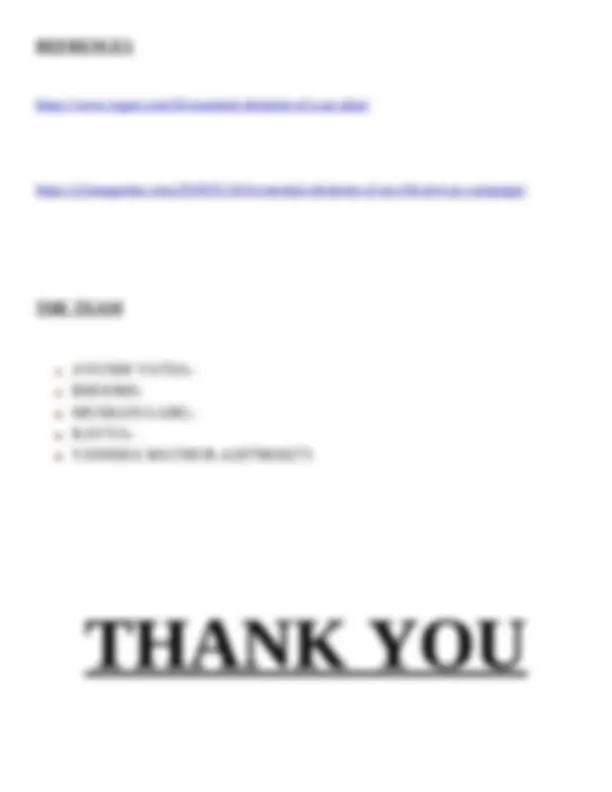


Study with the several resources on Docsity

Earn points by helping other students or get them with a premium plan


Prepare for your exams
Study with the several resources on Docsity

Earn points to download
Earn points by helping other students or get them with a premium plan
Community
Ask the community for help and clear up your study doubts
Discover the best universities in your country according to Docsity users
Free resources
Download our free guides on studying techniques, anxiety management strategies, and thesis advice from Docsity tutors
public relation, public relations strategy, Research
Typology: Assignments
1 / 21

This page cannot be seen from the preview
Don't miss anything!















On special offer
on POLIO & THE FEAR OF SYRINGES. Submitted To: The Health Ministry & The Department of Family Welfare.[The Government Of India.]
Poliomyelitis, often called polio or infantile paralysis , is an infectious disease caused by the poliovirus. In about 0.5 percent of cases there is muscle weakness resulting in an inability to move. The weakness most often involves the legs but may less commonly involve the muscles of the head, neck and diaphragm. Poliovirus is usually spread from person to person through infected faecal matter entering the mouth. It may also be spread by food or water containing human faeces and less commonly from infected saliva. The disease is preventable with the polio vaccine; however, multiple doses are required for it to be effective.
Polio causes a lot of symptoms in the body which include: Sore Throat Fever Nausea Vomiting Abdominal Pain Constipation
Diarrhoea Influenza
Poliomyelitis is caused by infection known as Poliovirus (PV). Individuals who are exposed to the virus, either through infection or by immunization with polio vaccine, develop immunity. In immune individuals, antibodies against poliovirus are present in the tonsils and gastrointestinal tract, and are able to block virus replication.
Poliomyelitis is highly contagious via the faecal-oral and the oral-oral routes. The disease is transmitted primarily via the faecal-oral route, by ingesting contaminated food or water.
Paralytic poliomyelitis may be clinically suspected in individuals experiencing acute onset of flaccid paralysis in one or more limbs with decreased or absent tendon reflexes in the affected limbs that cannot be attributed to another apparent cause, and without sensory or cognitive loss. A laboratory diagnosis is usually made based on recovery of poliovirus from a stool sample or a swab of the pharynx.
Wild poliovirus has not been found in India since 13 January 2011 meaning that, from that date, India is no longer a country where polio is endemic. Three years of being polio free is a notable milestone for the country as a whole, but the success of the immunization and awareness campaign has had a wider impact. With this achievement, it is hoped that soon the entire WHO South-East Asia Region can be certified polio free. A commission of experts will meet on 26-27 March 2014 to analyze the data and determine the polio status for the Region. Historically, India has been the largest endemic reservoir of polio in the world with between 50 000 to 100 000 paralytic polio cases occurring each year between 1978 and 1995. It has also been one of the main sources of polio importation for other countries. This achievement has been driven by the partnership between the Government of India, international organizations, local NGOs and other institutions. An extraordinary mobilization of health workers was necessary to reach this point, particularly in the Uttar Pradesh and Bihar states. The outcome of this has been an improved vaccine delivery system, better trained health staff and high quality surveillance, monitoring and research mechanisms.
This does not mean that the virus cannot reemerge within any of the countries or the Region. There is no room for complacency with ongoing polio vaccination work. High immunity levels must continue in order to protect those in the Region and as newer, more comprehensive interventions are developed, these too need to be rolled out. Furthermore, whilst no new cases of wild polio have been recorded recently, the disease in different forms can be brought in to the Region via those who have contracted it in other parts of the world and then travel to South-East Asia. Facts about Polio Certification In 1988, the forty-first World Health Assembly adopted a resolution for the worldwide eradication of polio. Here are some polio certification facts: No single country can be certified as polio free. WHO Regions as a whole are certified as polio free For certification, all countries in the WHO Region need to not register a case of wild polio for 3 years in the presence of high quality surveillance The formal process for certification of polio eradication was established in 1995 at the first meeting of the Global Certification Commission (GCC)
For more information on WHO South-East Asia Regional Office’s work on Polio, visit the immunization section. WHO India Country Office article on "Keeping the polio virus at bay".
This PR Campaign aims: To Inform and raise awareness in people about polio. To eradicate the fear of syringes. To provide facilitation of polio drops in tier 3 &4 villages.
For this PR Campaign we are going to target the following groups: The people and Citizens of the tier 3 & tier 4 cities of the country. The list of some such cities is being provided below; a complete list shall be provided if required.
A sample Poster has been attached herewith. The Frequency shall be Twice in a week for four months. 4 x 16 = 64 times in local and regional newspapers such as Hindustan Times, Amar Ujaala, and Punjab Kesari etc.
2. Outdoor Media: Transit Media [Buses, Trams, Auto- Rickshaw etc.] Billboards. This media shall be extensively used to create awareness in remote regions where other media is not able to reach adequately. The Ads shall be display type and shall be creatively informing about the aforesaid topic. By using common people and less of text. The text shall be in regional and local dialects. Hence creating a better relation with the people, this shall also increase the viewership on the ads. A billboard will be set up after every 100 Kms. approximately about 50,000 Billboards in all such cities of all the states.
3. Radio: This media shall be primitively used to reach remote places with the message. The radio shall consist of a PSA informing the people about the same theme. The PSA shall use a Celebrity Voice, tentatively a female actress. A Simultaneous PSA shall include the same content but in the regional and local dialects. Preferably Bhojpuri, Maithili etc. A jingle shall be created on the theme of ‘2 Boond Zindagi ki’. The Drive times as chosen are of the morning drive, the afternoon drive and also the evening drive. Every PSA shall be of 40 Secs and shall run thrice in a day. The FM Stations Chosen are AKASHVANI, FM GOLD, FM RAINBOW and VIVIDH BHARTI. 4. Traditional Media: Staying true to the roots, the Traditional media shall also be taken into account. We believe the best way reach to the audience is by engaging them in activities which require them to be involved. Through Nukkad Nataks and Lok Geets we aim at gaining a lot of attention of the common folk of these cities. The basic theme of the same shall be focussed on getting the irrational fears out of their minds about the polio vaccine and syringes.
This PR Campaign has to be carried out for 4 Months on all platforms as mentioned above. Total Funds Allocated: INR 50, 00,000/- [By the Govt. of India] A Cumulative Budget for the same has been presented below: Print Media - INR 5,00,000 /- Outdoor Media- INR 7,00,000/- Radio- INR 12,00,000/- Television – INR 15,00,000 /- Traditional- INR 1,00,000 /- Miscellaneous Expenses- INR 2,00,000 /- Total Cost - INR 42,00,000 /- Net Budget Allotted – INR 50, 00,000/- Net Budget Remaining- INR 8, 00,000/- Here the miscellaneous expenses include the cost and salaries for the PR Managers, Transportation, Camp setting etc.
This PR campaign shall use a Psychological and Emotional appeal to reach out to the audience. The message shall aim at bringing out the need of getting the polio vaccine to all the aforementioned cities and states. This campaign message also aims at removing the fear of needles and syringes in the minds of common people. The message shall be using an easy to understand language. With extensive use of local and regional dialects portrayed and presented by common people, or well-known individuals. We shall use an emotional appeal which shall instil a better understanding and knowledge of the subject. The PSA and TVC shall be created with a rural background. Aiming at increasing the awareness in such cities.
About 2.5 Lakh vaccine bottles shall be attained, which shall be simultaneously transported to the authorities well as the volunteer organisations. A substitute amount of vaccination of about 50,000 bottles has already been procured which shall be provided to the organisations in case the vaccine runs out.
3. Setting Up Camps: The vaccination booths and camps shall be put up in centre areas in the aforementioned cities. The booths shall be temporary and shall have all the need s and requirements to meet up with the expectations. The vaccination shall be provided according to the database created. A mark shall be made on the finger of the people already vaccinated. The mark shall be made by the use of a permanent black ink. This shall make sure that no body is vaccinated twice and everyone gets the required amount of vaccine. All these steps shall ensure a smooth and proper flow of information and vaccination to all the cities.
Campaigned By: TANISHA MATHUR KAVYA BHOOMI MUSKAN GARG AYUSHI DULCET PR Agency Contact Details: Email: dulcetpr@dulcetpr.org **Phone: 971******* 887*********